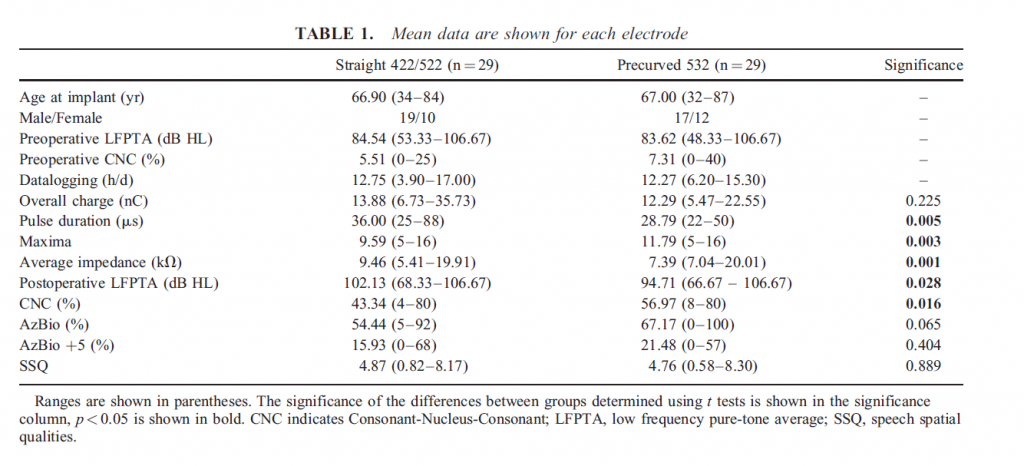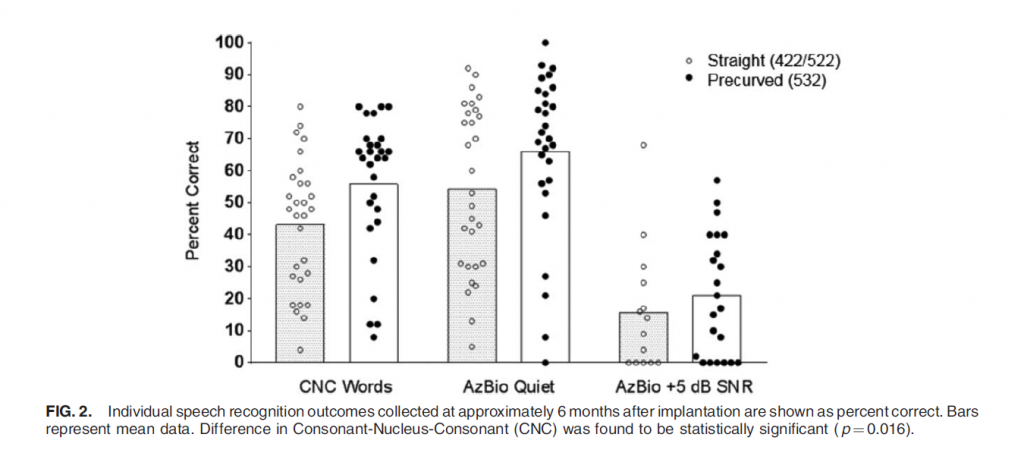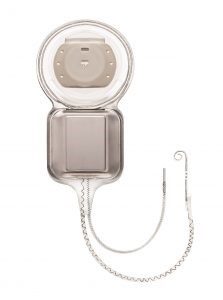
By Wade Colburn, Biomedical Engineer and Product Manager – Implants, Cochlear Americas
Matched Cohort Comparison Indicates Superiority of Precurved Electrode Arrays
JT Holder, RJ Yawn, AM Nassiri, RT Dwyer, A Rivas, RF Labadie, RH Gifford
Otology Neurotology (2019) 40(9): 1160 – 1666
In today’s busy clinical environment, clinicians who value research-based practice often struggle to keep up with current literature. To help, we offer a ProNews Blog monthly feature – Journal Club! Each month, rotating guest authors will present a current journal article summary.
This month’s Journal Club explores a recent 2019 study from Vanderbilt University, Matched Cohort Comparison Indicates Superiority of Precurved Electrode Arrays. Researchers analyzed the two primary types of electrode arrays within the marketplace: lateral wall or straight array and pre-curved or perimodiolar. Very seldomly are the array types compared using matched groups.
Historical studies have suggested the benefits of placing the electrode closer to the nerve, but often did not contain a comparison group. This article explores the comparison between pre-curved and lateral wall electrode design and demonstrates the superiority of pre-curved.
What did the study investigate?
Goals of the study:
- Better understand how electrode type affects programming parameters and patient outcomes to choose the best device for an individual
- Compare a newer generation precurved electrode with a straight electrode utilizing matched groups
Why is this important?
In the cochlear implant industry there are multiple electrode variants and choices between manufacturers. With that comes various evidence showing how implant technology, surgical technique and placement of the device can impact the outcome. Specifically, the authors call out that electrode design, intrascalar location, surgical approach and atraumatic insertion technique could impact performance. Various studies in the marketplace highlight the benefits of both lateral wall and precurved electrode types, but few draw a direct comparison using matched groups.
Straight arrays have a history of atraumatic insertions and greater potential for structural preservation, while precurved arrays have the outcome benefit of stimulation specificity.1 Due to recent changes in electrode design, this study aimed to compare a new perimodiolar array to a straight array. Authors hypothesized that the arrays would show similar hearing preservation rates, while the perimodiolar array would show better speech understanding scores and preferable programming parameters due to the lower electrode-to-modiolus distance.
How did they do it?
Here is your need-to-know:
- 29 precurved array patients
- 17 male/ 12 female
- 29 straight array patients
- 19 male/ 10 female
- Retrospectively reviewed aggregate clinical database and matched CI532 electrode recipients with CI422/CI522 recipients, controlling age and preoperative hearing thresholds
- Standard cochlear implantations via round window (RW), extended round window (ERW) and cochleostomy (C)
- CI422/CI522 Group: RW=23, ERW=3 and C=3
- CI532 Group: RW=18, ERW=5, C=6
- Speech recognition scores (CNC Word Recognition, AzBio Sentence Recognition in quiet, AzBio Sentence Recognition in +5 dB SNR), residual acoustic hearing thresholds (LFPTA at 125, 250, 500 Hz) and quality of life questionnaire data (Speech Spatial Qualities -SSQ) were obtained for patients both pre-operatively and post-operatively (6 months).
- Programming software parameters (pulse duration, maxima and datalogging) were also analyzed
- Matching controlled for age, preoperative LFPTA, preoperative CNC scores and daily processor usage
Results1
Age, preoperative LFPTA, preoperative CNC scores and daily processor usage were matched within the study to determine significance in the outcome measures and software parameters. The study found that impedances and pulse duration were significantly lower for the CI532 group, but there was no difference in overall charge between groups. Further, the study found that the CI532 group had significantly better post-operative CNC and LFPTA.
Table 1, provided below, outlines the parameters that were matched and analyzed within the study.

The study compared the speech outcomes directly. While only CNC had a significant difference, Figure 2 from the publication outlines the performance of the devices in CNC, AzBio Quiet and AzBio +5 dB.

The authors call out that “the most notable finding of the current study is that the CI532 group had significantly better post-operative acoustic LFPTA.” They continue, “This difference in results could be explained by lower rates of translocation for the CI532, which suggests less trauma of the cochlear structures”.

Further investigation shows that the observations regarding lower impedances and differences in pulse duration allow for the center to implement greater maxima, which has been known to have a positive impact on speech understanding in complicated listening situations.1
Results of this study indicate that there are many advantages to a perimodiolar array including closer proximity to the modiolus and decreased translocation rates. More research will be conducted in regards to this new perimodiolar array to assess the performance benefit and the potential for equivalent or better preservation rates, historically associated with lateral wall arrays.
Learn more about perimodiolar electrodes by accessing the publication and stay tuned for next month’s edition of Journal Club!
About our guest author: Wade Colburn is the Product Manager, Cochlear Implants at Cochlear Americas. Wade is responsible for managing product lifecycle and providing technical support to customers. Wade is a biomedical engineer from North Carolina State University with extensive experience within otology prior to joining Cochlear.
References:
- Holder, J. T., Yawn,
R. J., Nassiri, A. M., Dwyer, R. T., Rivas, A., Labadie, R. F., & Gifford,
R. H. (2019). Matched Cohort Comparison Indicates Superiority of Precurved
Electrode Arrays. Otology & Neurotology, 40(9), 1160–1166. doi:
10.1097/mao.0000000000002366











